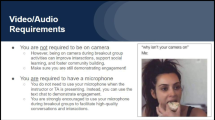Abstract
Technology can be thought of in two ways: as a set of tools that amplify or extend what we currently do (make it better, faster, stronger), or as something with the potential to radically change what we do or how we do it (Pea, R. D., Beyond amplification: Using the computer to reorganize mental functioning. Educational Psychologist 20: 167–182, 1985). As technological tools, e.g. the digital camera, become more common, teachers and students have increasingly integrated them into their work. This research attempts to answer two research questions about the digital camera as a technological tool in the science lab. Does the use of the digital camera in laboratory activities increase student learning? Does the use of the digital camera motivate students to take a greater interest in laboratory work? Two high school biology classes in an urban high school of 1300 students were used to carry out the study. One, the control group, did not use the digital camera during two lab activities, and the other, the experimental group did use the digital camera during the same lab activities. The results of the study indicated that the digital camera did increase student learning of process skills in the two biology lab activities. The results of unpaired t tests for independent data indicated the differences were statistically significant for the process questions, while the differences in responses to the content questions were not significantly different. Anecdotal evidence also indicated that the experimental group took more interest in setting up the apparatus and made fewer mistakes in the lab procedure than did the control group.
Similar content being viewed by others
References
American Association for the Advancement of Science (1993). Project 2061: Benchmarks for Science Literacy, Oxford University Press, New York.
Atwater, M. (2000). Equity for Black Americans in pre college science. Science Education 84: 154–179.
Brown, M., Higgins, K., and Hartley, K. (2001). Teachers and technology equity. Teaching Exceptional Children 33: 32–39.
Damarin, S. (2000). The ‘digital divide’ versus digital differences: Principles for equitable use of technology in education. Educational Technology 40: 17–22.
De Miranda, M. A., and Folkestad, J. E. (2000). Linking cognitive science theory and technology education practice: A powerful connection not fully realized. Journal of Industrial Teacher Education 37: 5–23.
Dugger, W. E. (1999). Putting technology education standards into practice. NASSP Bulletin 83: 57–63.
Francis-Pelton, L., Farragher, P., and Reicke, T. (2000). Content based technology: Learning by modeling. Journal of Technology and Teacher Education 8: 177–186.
Girod, M., and Cavanaugh, S. (2001). Technology as an agent of change in teacher practice. T.H.E. Journal 28: 40–45.
Klomp, J. (2002). The digital camera improves student learning. School Arts 101: 28–29.
Knuttle, K. (1998). Digital camera use in the classroom. Media and Methods 34: 58–60.
LaMaster, K. (2002). Smile—It's digital photography. Strategies 15: 37–38.
Medina, K., Pigg, M. and Desler, G. (2001). Teaching generation.com. Phi Delta Kappan 82: 616–620.
Mills, A. (2000). Teaching the digital generation—The challenge of relevance. Australian Science Teachers Journal 46: 30–35.
National Association for Educational Progress (2000). 1999 Trends in Academic Progress: Three Decades of Student Performance (NCES Publication No. 2000469), National Association for Educational Progress, Washington, DC.
National Resource Council (1996). National Education Science Standards, National Academy Press, Washington, DC.
O'Donovan, E. (1996). Picture this: Digital photography and desktop video come of age. Technology and Learning 16: 24–26.
O'Donovan, E. (2000). Input tools for the wired classroom. Technology and Learning 20: 50–60.
O'Sullivan, C., and Weiss, A. R. (1999). Student work and teacher practice in science: A report on what students know and can do. Project 2061, American Association for the Advancement of Science, Washington, DC.
Owens, O., and Waxman, H. C. (1998). Sex and ethnic related differences among high school students' technology use in science and mathematics. International Journal of Instruction 25: 43–55.
Pea, R. D. (1985). Beyond amplification: Using the computer to reorganize mental functioning. Educational Psychologist 20: 167–182.
Setters, P. (1999). Communicate with pictures. Learning and Leading with Technology 27: 36–39.
Stuhlmann, J., and Taylor, H. (1999). Preparing technically competent student teachers: A three year study of intervention and experiences. Journal of Technology and Teacher Education 7: 333–350.
Thompson, J. (2002). Picturing physics. The Science Teacher 69: 30–32.
Trowbridge, L. W., Bybee, R. W., and Carlson-Powell, J. (2000). Teaching Secondary School Science: Strategies for Develo** Scientific Literacy, Prentice-Hall, Englewood Cliffs, NJ.
Weiser, C. (1997). Using cameras in the classroom. Media and Methods 33: 16–20.
Author information
Authors and Affiliations
Corresponding author
Rights and permissions
About this article
Cite this article
Tatar, D., Robinson, M. Use of the Digital Camera to Increase Student Interest and Learning in High School Biology. Journal of Science Education and Technology 12, 89–95 (2003). https://doi.org/10.1023/A:1023930107732
Issue Date:
DOI: https://doi.org/10.1023/A:1023930107732




